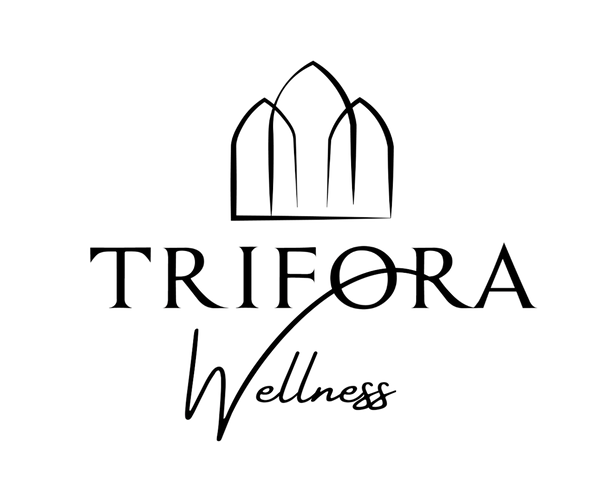Toxic Ingredients We Avoid

We believe in the power of natural active ingredients to support health and wellness. Many products on the market today contain chemicals that may be harmful, whether they hold toxic heavy metals, cause skin irritation, or act as endocrine disruptors affecting your hormones, it can be difficult to navigate the plethora of choices available to find what is truly safe, while also being effective.
At Trifora Wellness, we source products with natural ingredients, but that does not mean that every product is all natural; some may also contain synthetic ingredients. We have narrowed down a range of potentially harmful ingredient types that we avoid, and are careful that none of the products we stock contain them. In the list below, you can see what these are, and why they can be dangerous.
Natural active ingredients are not the only important factor to consider when choosing products that you will consume or apply to your body. Some natural ingredients can be toxic, such as sodium hydroxymethylglycinate, which is sometimes used as an alternative to parabens. We choose to avoid products containing that ingredient, and consider carefully the amounts of other common ingredients such as benzyl benzoate, sodium benzoate and benzyl alcohol (can be natural or synthetic) before choosing to add a product to our catalogue.
Other natural and non-toxic ingredients, such as essential oils, may cause irritation to specific individuals. While only you can know this about yourself, we have clearly listed the ingredients for each product so you can easily make informed choices.
You can check the icons on each of our product pages, showing you the specific features of that item, such as if it is certified organic, paraben-free, dairy free etc. You can even choose to only be shown search results that meet your specific criteria by filtering the Features menus on collection pages.
Whatever you are looking for, we hope we make it easier for you to find and decide what is right for you and your health at Trifora Wellness.
Parabens
Parabens are a group of chemicals that preserve personal care products, and are commonly found in shampoos, conditioners, moisturisers and makeup. They’re a type of endocrine disruptor that may result in reproductive disorders, affect birth outcomes and increase the risk of cancer. (Source: Environmental Working Group)
Sulphates
This includes Sodium Lauryl Sulfate (SLS) and Sodium Laureth Sulfate (SLES). They're often found in shampoo, toothpaste, body and hand washes to produce a foamy lather. They can irritate the eyes, skin and lungs, especially with long term use. While there is not yet direct evidence linking theses sulphates to cancer, SLES may be contaminated with a chemical called 1,4-dioxane, which has been shown to cause cancer in laboratory animals, and ethylene oxide, a known human carcinogen, nervous system disruptor and developmental toxin. (Source: Healthline)
Phthalates
Phthalates are commonly found in soaps, body washes, shampoo, conditioner, fragranced lotions, nail polish, perfume, cosmetics and deodorant. Phthalates are endocrine disrupting chemicals, affecting the hormone system by increasing the production of some hormones, decreasing the production of others and interfering with hormone signaling.
Phthalates are associated with health harms including changes to fertility, early puberty and risk of low birth weight, obesity, diabetes, impacts to the immune system, cardiovascular and respiratory problems including asthma and allergies, some cancers and neurological and behavioral problems. (Source: Environmental Working Group)
Triclosan
Triclosan is an antibacterial pesticide commonly found in antibacterial soaps and lotions, toothpaste, deodorant, shaving products and some cosmetics. It can cause changes in the human hormone system, harming reproduction and development. Recent studies also show that higher triclosan levels in people are linked to increased sensitivity to allergens. (Source: Environmental Working Group)
Propylene Glycol
Commonly used as a skin conditioning agent and found in shampoo, conditioner, hair colour, cosmetics, deodorant, moisturisers, serums, toothpaste and body wash. It has been associated with irritant and allergic contact dermatitis as well as contact urticaria in humans, which can occur even at low concentrations of propylene glycol. (Source: Environmental Working Group)
Synthetic Colours
Synthetic colours are commonly used in a range of food, drug and cosmetic products, including lotions and skincare, soaps, liquid cleansers, shampoo, conditioner, facial treatments, toners, deodorant, mouthwash, toothpaste, and makeup. They can contain heavy metals, like lead, the accumulation of which can contribute to cancer, developmental and reproductive problems, allergies, and a range of other health problems. (Source: PubMed)
Synthetic Fragrances
Synthetic fragrances can be found in almost all household and personal care products. They can contain phthalates as well as other chemicals known as potential carcinogens and disruptors of the endocrine and nervous systems. (Source: Campaign for Safe Cosmetics)
Synthetic Flavours
Whether or not artificial flavours are harmful is up for debate. We love to include bone broths and other foods in our product range. We're all about real, nutritious food, so we choose to avoid synthetic flavours. We make it clear for you to see what is and isn't in the products we stock, so you can make informed choices. (Source: Healthline)
Sunscreen Chemicals
Most sunscreens contain different chemicals used to block or absorb UVA and UVB radiation from the sun. According to the American Food and Drug Association (FDA), these ingredients (specifically oxybenzone, octinoxate, octisalate, octocrylene, homosalate and avobenzone) are all systemically absorbed into the body after one use.
The FDA has classified 12 ingredients in sunscreen as generally not safe. The European Commission has also found that several of these chemicals are not safe in the amounts they're used. Many studies have raised concerns about the endocrine-disrupting effects of three ingredients in particular: homosalate, avobenzone and oxybenzone. Only two ingredients, zinc oxide and titanium dioxide, could be classified as safe and effective. (Source: Environmental Working Group)









